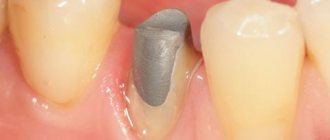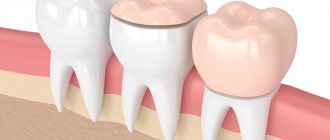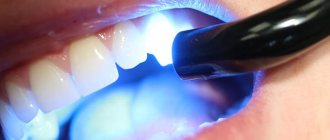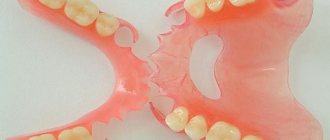In modern dentistry, there are many different methods for restoring damaged teeth - filling, prosthetics, installing inlays. The first two technologies are well known to patients, but few people know that teeth can be successfully restored with inlays.
What are tooth inlays, how do they differ from regular fillings, and in what cases is the use of inlays indicated? We will answer all these questions in detail in this article on our website.
What is it - a tooth tab?
Dental inlays are microprostheses that can be used for different purposes. Restorative or restorative inlays are used like fillings: they help recreate the natural crown of a tooth, keeping it alive. Stump inlays are used in cases where it is necessary to restore a badly damaged tooth under a crown. Let's take a quick look at why restoration and stump inlays are used, and find out the difference between them.
Restoring inlays are stronger than conventional dental fillings and differ from them in the technology of their creation: dental inlays are not made directly in the patient’s mouth, like fillings, but in a dental laboratory, using previously taken impressions. Because microdentures are made in a laboratory setting, they are also called indirect dental inlays.
The inlays exactly repeat the shape of the cavity that needs to be closed for tooth restoration and fit tightly to the natural tissues. The high density of adhesion of the inlay to the tooth tissue eliminates the risk of developing caries in the gap between the installed microprosthesis and the tooth. Restoring a tooth with an inlay will help keep the tooth alive in a situation where a sufficient amount of tooth tissue has been preserved, its nerve is alive and well, but a large filling still needs to be placed. Large fillings do not stick well to the teeth and can break under stress, along with the tooth. Inlays have a long useful life, can withstand chewing loads well, and their use makes it possible not to rush into dental prosthetics with a crown, which often requires preliminary depulpation of teeth.
Stump inlays for a tooth are no longer a restoration element, but a technical one. It acts as a support for the installation of a dental crown in cases where the tooth cannot be restored qualitatively with a conventional filling. In order not to confuse stump and restoration inlays, the easiest way to classify them is as follows: restorative inlays are installed outside the living tooth, stump inlays are always located under the crown.
This is the main classification of inlays, but they can also differ in the type of material they are made of, and below we will definitely talk about all the types of microprostheses and their features. But first, let's find out who and when is recommended to install inlays on teeth.
More examples
Example 1:
Here the tooth is cracked due to a large filling.
Example 2: filling with usual indications
Given:
Correct fillings:
Indications for dental restoration with inlays
Let's look at all the cases in which the use of tabs may be indicated. It is recommended to use tabs:
- If the tooth is destroyed by more than 1/3;
- With increased wear of chewing teeth;
- When restoring teeth that in the future will have to act as a support for a crown or installation of a bridge;
- For large carious cavities in the teeth, the elimination of which with conventional fillings is ineffective.
The need to use inlays is determined by the dentist during the examination of the patient. Based on the clinical situation, the specialist will choose the type of microprosthesis that is suitable for you, both in terms of functionality and material of manufacture.
Features of the ips e.max system.
Modern people think about and care about their health. A beautiful, natural smile is important to him, and in order to meet his ideal, he undergoes timely examinations with a dentist, and if problems arise, he begins treatment. Damage to the tooth structure can occur due to mechanical injuries, advanced pathologies, age-related changes and other reasons. According to Ivoclar Vivadent, IPS e.max metal-free ceramics is all we need. It was they who created this system more than 15 years ago and revolutionized aesthetic dentistry. As a result of research, it has been proven that this development has a lot of advantages, while it is easy to use and consists of several components. Depending on the specific clinical situation, the doctor selects the appropriate all-ceramic material.
Types of restoration dental inlays: description, characteristics
In this section of the article, we will tell you about what restoration dental inlays can be, used in tooth restoration as an alternative to conventional fillings. Prostheses will be classified mainly according to the material of manufacture and according to this criterion, the inlays can be ceramic, composite, or metal. The material of the tooth inlay will affect both the performance characteristics of microprostheses and their cost.
Ceramic tooth inlay and its features
Most often, ceramic dental inlays are used to restore chips on living teeth and act as a high-quality and more reliable alternative to conventional fillings.
Ceramic inlays can only be placed on teeth that are alive, not loose, and have been treated for caries. Ceramic dental inlays have many advantages: they are aesthetically pleasing, durable, do not change their beautiful color even with prolonged use, and do not wear off. The high density of the marginal contact of the ceramic inlay with the natural tissues of the tooth eliminates the risk of developing secondary caries.
But ceramic dental inlays have some disadvantages. Some consider the disadvantages of ceramic inlays for teeth to be the high price of this type of microprosthesis in Moscow (from 8 thousand rubles), however, it should be noted that the high cost is fully justified by the long service life of ceramic inlays and their impeccable aesthetics. Please note that with ceramic inlays installed on your teeth, you will need to give up the habit of chewing nuts, crackers, and other types of too hard foods with your teeth. The ceramic inlay may not withstand such heavy loads!
Metal tooth tab: characteristics, pros, cons
Metal restoration inlays are used quite rarely these days, and all because microprostheses made from this material have a number of disadvantages:
- When installing metal inlays in the mouth, a very unpleasant galvanic side effect for the patient may occur, expressed in constant and profuse salivation, a pronounced metallic taste in the mouth;
- Installing metal inlays does not allow for high-quality and tight contact between the microprosthesis and the natural tissues of the tooth, and this increases the risk of developing secondary caries. Gold inlays on teeth can provide a good fit, but their price will be high, because gold is a noble and expensive metal;
- Metal inserts can cause allergic reactions;
- The aesthetics of metal inlays also leaves much to be desired.
The only significant advantage of metal inlays for teeth is the fairly low price for this type of microprosthesis in Moscow. The cost of a metal tab in the capital’s clinics starts at 4,000 rubles for one orthopedic product.
Composite inlays for teeth
Composite inlays are used to restore single-rooted teeth, which include incisors and canines, that is, the front teeth included in the smile area.
Installation of a composite inlay can only be carried out if the tissue in the tooth being restored is preserved in a volume of at least 50%. Composite inlays are also called pin inlays because when they are placed in the tooth canal, a pin is first placed on which the dentist will apply the composite material in layers. If the tooth is severely damaged, installing an inlay on a pin is not recommended, since over time the pin may begin to wobble in the tooth canal and its mobility can lead to a fracture of the tooth root. If your tooth is more than half destroyed, you do not need a restoration, but a stump inlay followed by installation of a crown!
How much will a composite tooth inlay cost? The answer to this question will depend on what type of post and composite material the dentist uses during the restoration process.
The price of a restoration insert will also depend on the method of its manufacture. All inlays, except composite ones, are created in the laboratory using dental impressions. The tooth for the inlay must be ground down, although the volume of tissue removed will be less than the amount of dental tissue that is removed for the crown. The most complex manufacturing technology is for ceramic crowns, which are made from pressed ceramics: they are created using CAD/CAM computer technology. The complexity of the technology increases the price of ceramic inlays, but such microprostheses will have high anatomical accuracy, which means they will last longer.
Positive aspects of the products
The main advantages of using ceramic dental inlays are as follows:
- High aesthetic value that does not change over time.
- Full compatibility of prostheses with these products.
- High precision processing of the product, allowing it to come into maximum contact with the walls of the dental cavity.
- Tooth enamel hardly wears out.
- Possibility to prepare teeth for fastening crowns.
- Possibility of filling even large dental cavities.
- Resistant to dyes.
- No polymerization or shrinkage after installation.
- The products are much stronger and more durable than fillings. The strength of the installed material exceeds the strength of building bricks by 4-10 times.
- Preservation of the appearance of the dental organ and its functions when using them.
- They do not cause discomfort or the feeling of a foreign object being in the oral cavity.
How are restoration inlays installed on teeth?
Installing a restorative inlay on teeth is a multi-step process that always begins with a detailed diagnosis, which will include examination, radiography and computed tomography. After the diagnosis, the type of inlay is selected and a detailed treatment plan is drawn up.
The tooth on which the inlay is planned to be placed is ground down and then an impression is taken from it and sent to a dental laboratory. An inlay will be made based on the impression and the average production time is 5-7 days.
When the inlay is ready, the patient is invited to the clinic for fitting and installation of a microprosthesis. The inlay is fixed in the tooth cavity using special dental cement.
Application of CEREC
CEREC technology is used to place veneers, restorations, crowns and small bridges in one visit. The latest generation of CEREC devices provides new opportunities when installing implants - the concept of integrated implantology with the CEREC system allows you to draw up a plan for surgical and orthopedic intervention, install implants in accordance with the surgical template. CEREC MC XL Premium Package devices can be used to produce not only restorative inlays and onlays, veneers and classic crowns, but also individual abutments, telescopic crowns, beam structures, and bridge frames. Some photos of our work
The CEREC PREMIUM system is designed for clinics that specialize in metal-free ceramics; structures can be made of zirconium dioxide, ceramics, polymer plastic, and less often of base metals.
CEREC jaw scanning technologies are also used in orthodontics. With their help, a digital impression is created, on the basis of which orthodontic appliances are modeled and manufactured. This technique is often used in orthodontic treatment with the help of aligners - transparent silicone or plastic structures made like caps. The CEREC system makes aligner fabrication fast and precise, allowing you to begin orthodontic treatment much faster than was previously possible using traditional aligner impressions.
Is it possible to put an inlay on the front teeth?
Inlays are not used for the restoration of anterior teeth. If there is a sufficient amount of healthy tooth tissue, the tooth is restored with a regular filling and then a veneer or lumineer can be placed on it to obtain a beautiful aesthetic restoration in the smile area. If the tooth is severely damaged, then it makes sense to install a stump tab and then a crown.
The traditional area of application for restoration inlays is chewing teeth.
Flaws
Ceramic dental inserts have virtually no disadvantages. But there are still shortcomings. This is primarily a high cost compared to the price of installing a filling, which is explained by the high cost of the materials used and the complexity of manufacturing.
In addition, treatment with onlays is longer than with a conventional filling and may require several visits to the dentist.
Another disadvantage is the presence of contraindications for the use of overlays.
Can a tooth get sick under an inlay and what to do if this happens?
If the tooth under the inlay hurts, you need to urgently contact a dental clinic, because pain under the installed microprosthesis can indicate the development of various kinds of complications. The main cause of complications after installing an inlay is medical errors that were made during the treatment process, and that is why it is so important to choose dentistry carefully! If, when treating a tooth, the doctor allows the pulp to overheat, an inflammatory process may begin, as a result of which the tooth under the tab will become sore. To eliminate pulpitis, you will have to remove the tooth inlay, receive appropriate treatment, and then restore the tooth again, possibly with a prosthetic crown or even implantation.
Inlays are often placed on teeth after caries treatment and it is extremely important that when working with a carious cavity, the dentist removes all destroyed tissue. If this is not done, secondary caries will begin under the tab, the treatment of which will again require removal of the tab.
Remember that if 5-7 days have passed after installing the inlay on the tooth, and your tooth hurts and the intensity of the pain is increasing, you need to urgently see a dentist, and not try to solve the problem yourself! If the infection gets into the root part of the tooth, it is not always possible to save the tooth and avoid its removal!
If the tooth does not hurt, but you have the feeling that it is bothering you - when eating, talking, trying to close your teeth - contact the clinic where you received the inlay to have its size corrected.
Stages of installation of a microprosthesis
During the first visit, the specialist conducts a careful visual inspection of the damaged element and examines the X-ray image. Next, he selects the appropriate treatment vector. To begin with, be sure to treat the carious cavity, remove necrotic areas, disinfect and prepare hard tissues. If necessary, depulpation is performed (the nerve is removed), after which the doctor cleans and seals the canals. After the cavity has been fully prepared, the doctor takes impressions and sends them to the laboratory. Impressions are also taken from the antagonist tooth. This allows you to determine how the tab should be positioned so as not to interfere with the correct closure of the jaws. Until it is ready, the patient is given a temporary filling.
At the second visit, the temporary filling is removed and the orthopedic product is tried on. If there are no complaints and the structure does not need to be sent for correction, it is fixed with durable dental cement. The excess is removed, the surface of the crown is ground and polished.
Stump inlays: what do you need to know about them?
At the very beginning of our article, we said that stump inlays should not be confused with restorative microprostheses - they are used to restore pulpless and severely damaged teeth, in which they will serve as the basis for installing a crown or dental bridge.
Stump inlays are structures consisting of two parts: a pin installed in the root canal and a support on which the crown will be fixed. Stump inlays can be monolithic or collapsible, and most often this type of structure is used when the tooth has less than 50% of healthy tissue left.
Many people are interested in the question: why is it best to use core inlays rather than fillings on a pin to restore severely damaged teeth? The fact is that the pin may not withstand the load and begin to wobble in the canal, and this will either lead to the filling breaking or falling out, or, worst of all, to damage to the tooth root, in which the tooth is most often removed. Stump inlays allow you to avoid such risks because they distribute the load more correctly and themselves have much greater strength compared to pins.
Stump inlays are also made in the laboratory and the construction material is selected to match the type of dental crown that is planned to be placed in the future. Metal core inlays are used for metal-ceramic crowns, and zirconium inlays are used for ceramic crowns. If you make a metal inlay for a ceramic crown, it can shine through the thin and transparent material of the crown, which will have a bad effect on the aesthetics of the restoration.
Tooth restoration using a core inlay will also be divided into several stages: diagnostics, preparation, during which a cavity is formed in the tooth for the inlay, manufacturing of the inlay, and its installation. After installing the core tab, the crown is fixed on it and this completes the process of tooth restoration.
If the tooth is destroyed, but there is a living nerve in it, before installing the stump tab, depulpation is carried out, as well as treatment and filling of the root canals. It is important that these procedures are carried out without errors, since poor canal processing leads to various kinds of complications, the elimination of which requires complex and lengthy treatment.
Tab lifespan
The service life of restoration inlays will depend on the material and production technology of microprostheses, as well as on how accurately the patient follows the dentist’s recommendations. Composite inlays last about 5-7 years, ceramic inlays - up to 20 years. This is subject to high-quality dental and oral hygiene and regular visits to the clinic for preventive examinations.
Stump inlays can last you a lifetime, and crowns on them last up to 15-20 years.
Do you still have questions about restorative and core dental inlays? Ask them to the orthopedists of our dentistry in Moscow - Vanstom! You can make an appointment with the clinic’s doctors at any time convenient for you - through the chat on our website, the call back form, or simply by dialing the contact phone number!
Care and possible complications
For the entire period of production of the ceramic inlay, the tooth cavity is filled with a temporary filling, so the patient must be quite careful, otherwise there is a risk of the filling falling out and damaging the tooth, which without a prosthesis becomes very vulnerable. After the inlay has been installed, the doctor usually advises you to avoid eating solid foods for at least a couple of days, and also not to clench your jaw too hard. No special care for the inlays is required - it is enough to carry out daily high-quality hygiene and regularly make preventive visits to the doctor. Patients are often concerned about possible complications associated with the installation of a ceramic inlay. If the treatment was carried out by a qualified specialist and high-quality materials and good equipment were used, there should be no cause for concern. Most often, complications arise due to errors at the planning and manufacturing stage of the inlay.
- Untreated dental diseases that develop already under the tab.
- Ignoring contraindications to the installation of a microprosthesis.
- Wrong color selection.
- Errors in calculations and production of the prosthesis. Because of this, microgaps most often occur.











